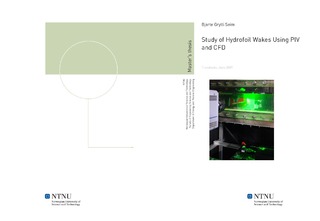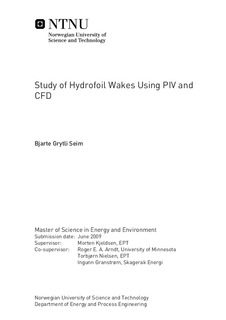| dc.contributor.advisor | Kjeldsen, Morten | nb_NO |
| dc.contributor.advisor | Arndt, Roger E. A. | nb_NO |
| dc.contributor.advisor | Nielsen, Torbjørn | nb_NO |
| dc.contributor.advisor | Granstrøm, Ingunn | nb_NO |
| dc.contributor.author | Seim, Bjarte Grytli | nb_NO |
| dc.date.accessioned | 2014-12-19T11:44:33Z | |
| dc.date.available | 2014-12-19T11:44:33Z | |
| dc.date.created | 2010-09-04 | nb_NO |
| dc.date.issued | 2009 | nb_NO |
| dc.identifier | 348856 | nb_NO |
| dc.identifier | ntnudaim:4878 | nb_NO |
| dc.identifier.uri | http://hdl.handle.net/11250/233671 | |
| dc.description.abstract | In this master thesis the wake of a hydrofoil have been investigated using PIV. The main goal of this work have been to investigate how vortex generators can create mixing and smoothing of the velocity deficit in hydrofoil wakes. This study is motivated by the rotor stator interactions in Francis turbines with the idea that smoother wakes from the stator can reduce the forces on the rotor and hence increase the life span of Francis turbines. A literature survey of foil theory and wake flows have been carried out. This survey motivated the use of a normalization of the velocity in the wake. Experimental work was carried out at the water tunnel facility at Saint Anthony Falls Laboratory at the University of Minnesota. Tests were performed on a NACA0015 hydrofoil with four different vortex generator configurations, for a range of different angles of attack and velocities. Lift and drag forces on the hydrofoil was measured using a force balance. Because the drag measurement had poor accuracy, it could not be used to compare the different vortex generator configurations in terms of drag. As a result the drag was investigated using the velocity deficit in the wakes. The quality of this analysis have been discussed with the use of CFD. CFD is also used to gain insight into how pressure and velocity is distributed in the water tunnel. The PIV images from the tests have been processed into vector fields with the commercial PIV software DaVis7. For analyzing the PIV data further, different post-processing schemes in DaVis7 was investigated together with programs developed in Matlab. In order to compare the wakes resulting from the use of different vortex generators with measurable quantities, the use of a standard wake profile has been investigated. The standard wake profile is symmetrical and could hence only describe wake measurements done at an angle of attack close to $0^{circ}$. Furthermore it turned out that most vortex generators resulted in a wake that could not be described with the standard wake profile. The vortex generator configurations that gave the best smoothing of the hydrofoil wake for the investigated operation points turned out to be a $1unit{mm}$ V-shaped vortex generator. This vortex generator also caused less drag than than the other vortex generators tested. However, the use of vortex generators resulted in increased drag compared to the plain hydrofoil for the analyzed operating points. The velocity deficit in the wake is shown to get so well smoothed out for some tested cases that it is considered worth while to continue the investigation on vortex generators capability to increase the lifespan of Francis turbines. | nb_NO |
| dc.language | eng | nb_NO |
| dc.publisher | Institutt for energi- og prosessteknikk | nb_NO |
| dc.subject | ntnudaim | no_NO |
| dc.subject | SIE5 energi og miljø | no_NO |
| dc.subject | Varme- og energiprosesser | no_NO |
| dc.title | Study of Hydrofoil Wakes Using PIV and CFD | nb_NO |
| dc.type | Master thesis | nb_NO |
| dc.source.pagenumber | 82 | nb_NO |
| dc.contributor.department | Norges teknisk-naturvitenskapelige universitet, Fakultet for ingeniørvitenskap og teknologi, Institutt for energi- og prosessteknikk | nb_NO |

